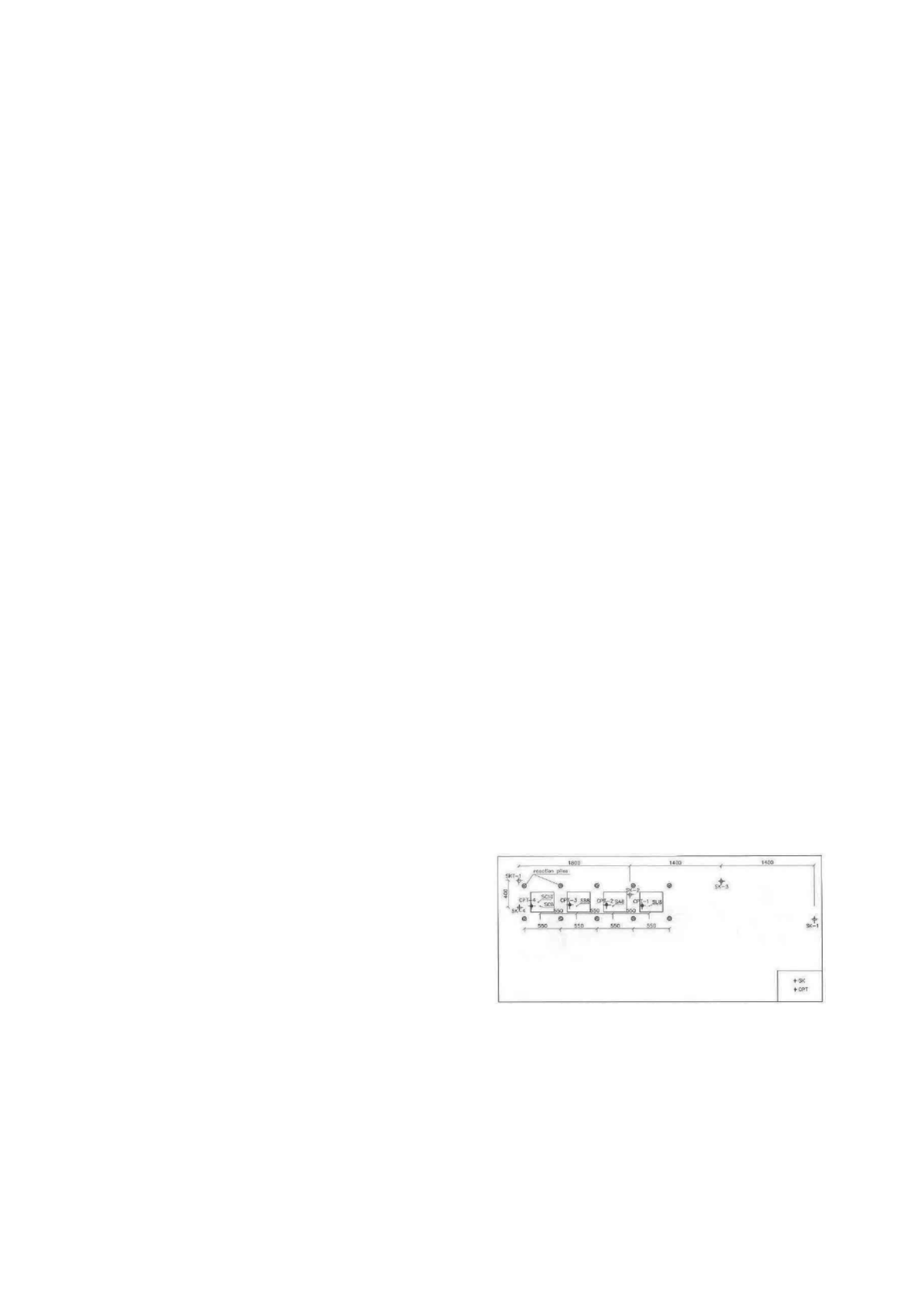
3455
Settlements Under Footings on Rammed Aggregate Piers
Tassements sous des semelles sur
pieux d’
agrégats battus
Kuruoglu O., Horoz A.
Yuksel Proje International, Turkey
Erol O.
Middle East Technical University, Turkey
ABSTRACT: This study uses a 3D finite element program, calibrated with the results of a full scale instrumented load test on a
limited size footing, to estimate the settlement improvement factor for footings resting on rammed aggregate pier groups. A simplified
3D finite element model (Composite Soil Model) was developed, which takes into account the increase of stiffness around the piers
during the ramming process. Design charts for settlement improvement factors of square footings of different sizes
(B = 2.4m to 4.8m) resting on aggregate pier groups of different area ratios (AR = 0.087 to 0.349), pier moduli
(E
column
= 36MPa to 72MPa), and with various compressible clay layer strengths (c
u
= 20kPa to 60kPa) and thicknesses
(L = 5m to 15m) were prepared using this calibrated 3D finite element model. It was found that, the settlement improvement factor
increases as the area ratio, pier modulus and footing pressure increase. On the other hand, the settlement improvement factor is
observed to decrease as the undrained shear strength and thickness of compressible clay and footing size increase.
RÉSUMÉ : Cette étude utilise un modèle de calcul en éléments finis 3D, calé à partir
sur les résultats d’essais de chargement grandeur
nature , totalement instrumentés, sur une semelle de dimensions limitées, dans le but d'estimer le facteur d'amélioration du tassement
des semelles reposant sur des groupes de pieux en agrégats, battus. Un modèle simplifié par éléments finis 3D (modèle de sol
composite) a été développé ; il prend en compte l'augmentation de la rigidité autour des piles pendant le processus de battage. Les
abaques des facteurs d'amélioration de tassement d’une semelle carrée de dimensions variables (B = 2,4 m à 4,8 m) reposant sur des
groupes de pieux en agrégats battus, avec des rapports de surface variés (AR = 0,087 à 0,349), modules de pile (Ecolumn = 36MPa à
72MPa), et avec différentes couche de renforcement d’argile compressible (c
u
= 20 kPa à 60 kPa) et épaisseurs (L = 5m à 15m) ont été
préparés en utilisant ce modèle en éléments finis
3D. D’une part,
i
l a été constaté que le facteur d’amélioration du tassement croît en
fonction de l’augmentation du rapport de la surface, du module de pile et de la pression des semelles. D'autre part, le facteur
d’amélioration du tassement diminue lorsqu
e la résistance au cisaillement non drainé, l'épaisseur de l'argile compressible ainsi que les
dimensions des semelles croissent.
KEYWORDS: rammed aggregate pier, stone column, settlement improvement factor
1 INTRODUCTION
This study uses a 3D finite element program, calibrated with the
results of a full scale instrumented load test on a limited size
footing, to estimate the settlement improvement factor for
footings resting on rammed aggregate pier groups. A simplified
3D finite element model (Composite Soil Model) was
developed, which takes into account the increase of stiffness
around the piers during the ramming process. Design charts for
settlement improvement factors of square footings of different
sizes (B = 2.4m to 4.8m) resting on aggregate pier groups of
different area ratios (AR = 0.087 to 0.349), pier moduli
(Ecolumn = 36MPa to 72MPa), and with various compressible
clay layer strengths (c
u
= 20kPa to 60kPa) and thicknesses
(L = 5m to 15m) were prepared using this calibrated 3D finite
element model.
2 CALIBRATION OF THE FINITE ELEMENT MODEL
The finite element model that is going to be used for the
parametric studies that will be presented in the proceeding
chapters of this study is calibrated with the results of full-scale
field load tests detailed in Özkeskin (2004). The full scale field
tests consist of load tests on both untreated soil and on three
different groups of rammed aggregate piers with different
lengths on the same site, and therefore offers the unique
opportunity of calibrating geotechnical parameters for a finite
element model.
The test area which is approximately 10m x 30m is located
around Lake Eymir, Ankara. Site investigation at the test area
included five boreholes which are 8m to 13.5m in depth, SPT
tests, sampling and laboratory testing, and four CPT soundings.
(see Figure 1)
Figure 1. Location of boreholes and CPT soundings at the test site.
The variation of SPT-N values with depth is given in Figure
2. It can be seen that, SPT-N values are generally in the range of
3 to 10 in the first 8 m. After 8 m depth, SPT-N values are
greater than 20, and the samples are identified as weathered
graywacke. Based on the laboratory test results, the
compressible layer, first 8 m, is classified as low plasticity clay
(CL) and clayey sand (SC) according to USCS. The liquid limit
of the compressible layer changes predominantly in the range of
27% to 43% with an average of 30%, and the plastic limit


